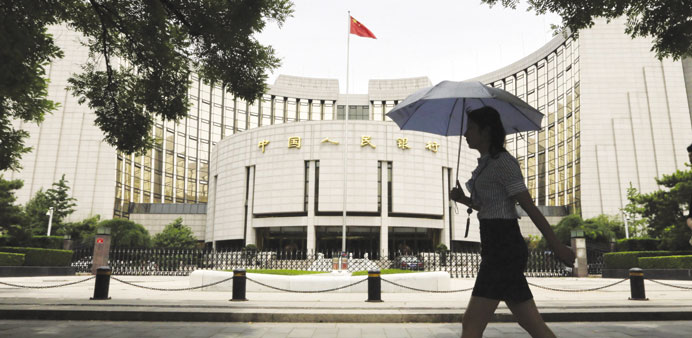A pedestrian walks past the People’s Bank of China headquarters in Beijing. China’s central bank is making its reserve requirement rules more flexible for banks to reduce the risk of an abrupt tightening in liquidity in the world’s second-largest economy as it cools.
Reuters/Beijing
China’s central bank is making its reserve requirement rules more flexible for banks to reduce the risk of an abrupt tightening in liquidity in the world’s second-largest economy as it cools.
The amount of deposits that banks must set aside as reserves at the central bank will soon be regulated on an average basis as opposed to current daily assessments, the People’s Bank of China (PBoC) said in a statement on its website.
The change, effective September 15, will help banks combat sudden funding pressures at a time of heightened volatility in the yuan that has driven capital from China. In two online statements, the PBoC said the new rule would allow banks to set aside less reserves when they are strapped for funds, but will not be a free pass for lenders to lapse into overdrafts.
Under the changes, banks can report a daily reserve requirement ratio (RRR) that is up to 100 basis points lower than the rate set by the PBoC, but their daily average RRR in the assessed period cannot fall under the required level.
The PBoC did not state the period over which banks’ RRR will be assessed.
“It could release a certain amount of liquidity when there is a shortfall,” the PBoC said of the rule, but added it would not affect the market now as there was ample liquidity.
The RRR is a main monetary policy tool in China, used to manage liquidity.
As China’s economy eases towards its slackest growth in 25 years, the PBoC has lowered the RRR three times this year by a total of 200 basis points to bolster bank lending. The PBoC sets different RRR requirements for banks depending on their size and type of loans. The RRR for the largest banks is around 18%, but the exact level for each bank is not disclosed.
“This helps to reduce volatility in liquidity,” said Li Qilin, an analyst at Minsheng Securities in Beijing.
“The (yuan) exchange rate is under pressure to depreciate and money flows are very volatile, which could affect the cash positions (of banks),” Li said. “This helps smooth it out.”
China’s foreign exchange market experienced its most volatility in a decade this year when the PBOC unexpectedly devalued the yuan by around 2% in August, saying it would deepen reforms. Faced with suspicion China may have started a round of competitive devaluations, which authorities deny, the PBoC has aggressively intervened to prop up the yuan. China suffered a bruising credit crunch in June 2013 when short-term interest rates shot as high as 30% after the PBoC allowed the money market to convulse to force banks to curtail risky lending.
China new loans fall as lending to support stock market fades in August
Reuters/Shanghai/Beijing
Chinese banks extended 809.6bn yuan ($127.04bn) of new loans in August, less than expected as the impact of the government’s massive stock market rescue on the financial system faded.
Economists polled by Reuters had forecast banks made 900bn yuan of new loans last month as the stock market rout showed signs of easing.
Banks had made 1.48tn yuan ($232.24bn) of new loans in July, the highest monthly reading since 2009.
Economists believe that figure was heavily inflated by Beijing’s move to pump billions into equity markets through banks and other agencies to avert a full-blown crash, and did not signal any improvement in weak loan demand in the broader economy.
Indeed, loans extended to non-bank financial institutions skyrocketed to 886bn yuan ($139.03bn) in July, accounting for the lion’s share of new lending (60%) that month. Excluding such loans, new lending actually fell month-on-month in July. In contrast in August, net new lending to non-bank financial institutions declined by 54.6bn yuan. “August new bank lending eased to normal after last month’s surge and M2 stayed at relatively high levels, indicating the central bank had kept its loosening monetary policy stance to support the struggling economy,” said Zhou Jingtong, analyst at the Bank of China in Beijing.
Growth in broad money supply (M2) in August was 13.3% year-on-year, equal to July’s 13.3%. Economists had predicted 13.2% growth. As sluggish demand leaves them with more idle capacity, many Chinese companies are in no mood to take on new loans for expansion and complain real borrowing costs are still too high, despite five interest rate cuts by the central bank since November.
Morever, banks are becoming more cautious about lending as the slowing economy leads to a sharp increase in bad loans.
“Monetary policy is relatively loose. But we should note that it’s difficult for large amount of money to enter the real economy and the problem of high borrowing costs cannot be resolved quickly,” said Li Huiyong, economist at Shenyin & Wanguo Securities in Shanghai. “I expect 25-50 bps cuts in interest rates and one RRR cut each month by the end of the year.”
Total social financing, a broader measure of net new credit, rose to 1.08tn yuan ($169.46bn) n August from 718.8bn yuan in July. Rises in bond financing (up 94.1bn yuan on the year) and trust loans (up 83.2bn yuan) led the increase.


